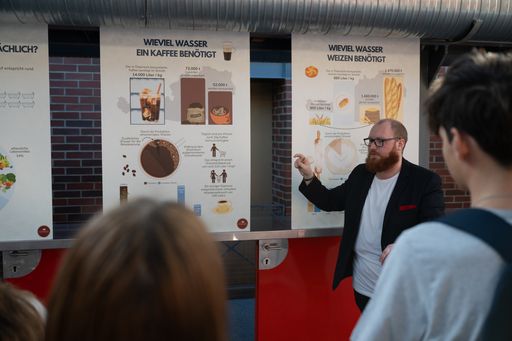On average, people in Austria use around 130 liters of water per person per day – so far, so known. However, very few people are aware that it is actually almost 30 times as much. The fresh water required to produce the products we use every day is around 4,700 liters or 20 full bathtubs. The majority of this is used to produce animal and plant foods, but a lot of water is also used to produce textiles and industrial products. It is also imported into water-rich Austria from regions of the world where water is becoming a scarce commodity.
The so-called “virtual water” was one of the central themes of the “Austrian consumer dialogues: water“, which ended yesterday after two days in the Working World Museum in Steyr. A separate exhibition, the contents of which can also be accessed viaVirtualswasser.at, and a discussion with researcher Roman Neunteufel were dedicated to the invisible good. Around 1,500 people, including many children and young people, took part in the 6th edition of the COMÚN Foundation’s unique series of events to impart knowledge and raise awareness and took part in one of the dozens of free activities on October 9th and 10th.
From drinking water to flooding: technically sound, practical experience
The “Consumer Dialogues” program was developed in collaboration with the five water institutes of the University of Natural Resources and Life Sciences; other central partners were the Federal Ministry of Agriculture, Forestry, Regions and Water Management (BML, Water Management Section), the Institute for Applied Environmental Education & BAFEP Steyr and the State of Upper Austria and the city of Steyr. In addition to “virtual water”, drinking water, its availability and quality were also discussed, the potential of hydropower was jointly questioned and the dangers posed by weather extremes, especially floods, were discussed. The focus was on scientifically based facts and, during station operations, there was also the opportunity to get a practical idea.
For COMÚN board member and organizer Sebastian Bohrn Mena a best practice: “It was both a pleasure and an honor for us to have such strong partners at our side for the implementation. Together we have succeeded in broadening our expertise and providing an impulse to become even more aware of the importance of water in all its forms. It is important to know where there is water and where it comes from. At the same time, we should also be aware that the water around us will change as a result of climate change. Wetlands in particular play an important role that we must and will shed more light on.“
Wonderful world of wetlands: Water Minister Totschnig chooses winning photos of the water active competition
Speaking of wetlands: The floodplains, rivers, ponds and moors and their special significance were another focus of the “consumer dialogues”. They were also the focus of Water Minister Norbert Totschnig’s visit: “Water is one of our most valuable resources. Our rivers, lakes and wetlands make a significant contribution to water storage and flood protection. They are not only valuable habitats, but also central elements in the fight against the consequences of climate change. In Austria we work intensively to protect and renaturate these habitats, because every square meter of intact moor and every floodplain is crucial for our future. Our goal is to make the public aware of the importance of these issues and to develop solutions together. That’s why I’m very pleased that a total of 899 submissions were received for this year’s water active photo competition and that I can award the best today. I would like to warmly congratulate all participants and thank them for their commitment, which gives me strength and confidence for our water future.”
Positive summary from city & country
The state of Upper Austria supported and promoted the Water 2024 consumer dialogue, which focused on the value of water, bodies of water and protection from water. The water management department was able to present its diverse tasks and services for the population of Upper Austria through hands-on stations such as drinking water tasting, leak detection in water pipes and various flood stations. In this way, the diverse facets of water could be experienced and brought closer to the population.
Markus Vogl, mayor of the city of Steyr, also draws a positive conclusion: “I am very pleased that Steyr was able to host the consumer dialogues again. For Steyr, water is a central theme that has shaped the city’s history. The city’s location on two rivers has brought prosperity and work, but also destruction from floods. It’s nice that so many people and especially students took the opportunity to deal with all facets of the topic“, says Mayor Markus Vogl.
A review of the entire “Konsumdialoge” program as well as extensive photo documentation can be found at verbrauchdialoge.at/wasser.
Information about the photo competition: www.wasseraktiv.at
